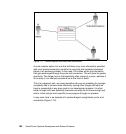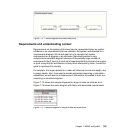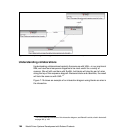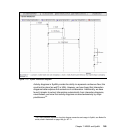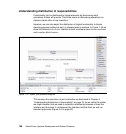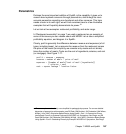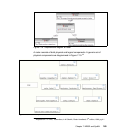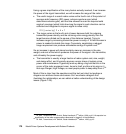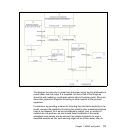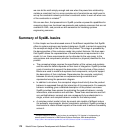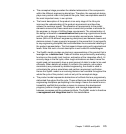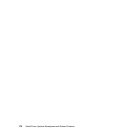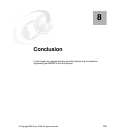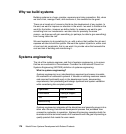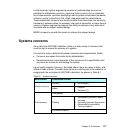
170 Model Driven Systems Development with Rational Products
Using a gross simplification of the many factors actually involved, if we increase
the power of the signal transmitted, we will increase the range of the radar:
The useful range of a search radar varies as the fourth root of the product of
average radio frequency (RF) power, antenna aperture area (which
determines antenna gain), and the time allowed to scan the required solid
angle of coverage (which limits how long the signal in each direction can be
collected and integrated to improve signal-to-noise ratio):
R^4 [varies by] P x A x T
The range varies as the fourth root of power because both the outgoing
transmitted power density and the returning echo energy density from the
target become diluted as the square of the distance traveled. Trying to
increase range by increasing transmitter power is costly: A 16-fold increase in
power is needed to double the range. Conversely, negotiating a reduced
range requirement can produce remarkable savings in system cost.
15
So an increase in power will almost certainly mean an increase in the size,
weight, and cost of that which produces the power of the signal—the transmitter,
and ultimately the power supply:
The transmitter is usually a large fraction of radar system cost, size, weight,
and design effort, and it typically requires a major share of system prime
power and maintenance. It generally ends up being a big box that sits in the
corner of the radar equipment room, hums to itself, and has a big sign on it
that says Danger, High Voltage; so most people prefer to keep away from it.
16
Most of this is clear from the equations and the text just cited, but perhaps a
diagram can reinforce these conclusions. So if we create a diagram that
illustrates the relationships, we can obtain a better understanding of the design
issues (Figure 7-20).
15
T.A. Weil, Transmitters, in M. Skolnik, Radar Handbook, 2
nd
edition, 1990, pg 4.2. His equation is a
simplification of the radar range equations discussed in chapter 2 of the handbook.
16
T.A. Weil, Transmitters, in M. Skolnik, Radar Handbook, 2
nd
edition, 1990, pg 4.3



